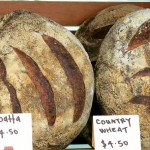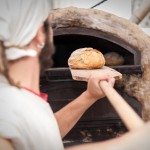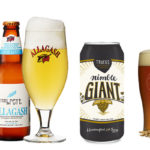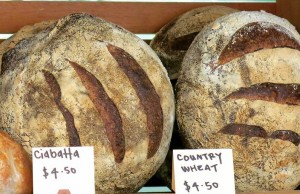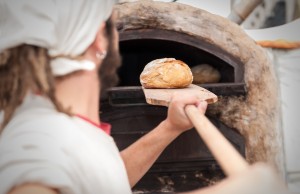How Breadmaking Became an Art
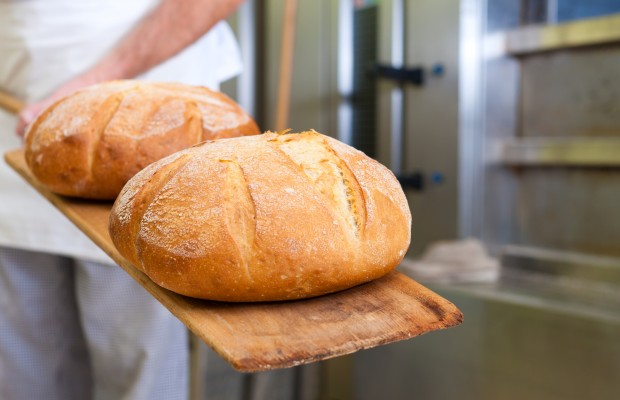
Bread making is going back to its roots, thanks to artisan bakers such as Kathy Hester, who owns the New Mexico-based BakeHouse with her husband, Tom. Hester specializes in traditional European Sourdough and naturally leavened breads. Using natural yeast strains, from start to finish it can take between 24 to 30 hours to produce a loaf of bread. We talked to Kathy about what goes into baking artisan bread and why the movement is revolutionizing the industry.
Question: Can you tell us a bit about what it really means to be a Traditional European Sourdough Bread Baker?
Kathy Hester: This title actually classifies the style of baking that I do. More often then not sourdough in the US is thought of in terms of California Sourdough, and is experienced as a “flavor.” This is true in the sense that in the SF Bay Area of California, because of the micro-climate that exists, the wild yeast spores in the region actually permeate any sourdough starter that is nurtured, and this wild yeast spore has been identified and named: lactobacillus sanfranciscensis. It’s this amazing yeast spore that gives SF California Sourdough its very unique flavor.
But what the title really identifies for anyone who is a professional baker is “how” I make my breads. What it means is that I use a Sourdough Starter to leaven my breads rather than using commercial yeast. I also focus on time and temperature to develop my bread dough. In a curious sense, I have more in common with a micro brewmaster than I do with most commercial bakers of today.
Q: Are the breads you bake really close to “old time” breads? How?
KH: Apart from growing my own wheat and grinding my own flour, what identifies our breads with the breads of past is the method of baking, i.e., using a traditional wood-fired oven, and the formulas (recipes) that I use. My passion is the history these breads have. I research the history on every bread that I bake, including our bagels and bialys. This offers me great satisfaction as a baker, to know how the breads were used and relied upon. I am then able to educate people who enjoy my bread and ask, “why have I not tasted or seen bread like this outside of Europe?”
One of the most fascinating history lessons I’ve experienced was when I decided to make Bialys for our Las Cruces, NM customers. I was born in Brooklyn, NY and spent most of my life growing up and living in New Jersey. Bialys are a large part of the Jewish culture. I wanted to have a full understanding of the Bialy, since I knew that bringing them to Las Cruces, NM would be a challenge in the state of Green Chili and Tortillas!
As I read through The Bialy Eaters by Mimi Sheraton, I was in awe and humbled as it was revealed that this simple bread barely survived the Holocaust and in time reappeared in the Brooklyn NY Jewish Communities. The emotional connection with the Bialy and the Holocaust is very powerful. And the decision to bring them to Las Cruces was affirmed when I had a Jewish customer come to BakeHouse and gasp in disbelief at the bialy offered for sale at our BakeHouse booth. She asked me if I knew what a bialy was? It was then, as the baker of this amazing little bread, that I had earned my right to bake this bread. For as I shared with her my understanding and knowledge of it’s history, she shared with me that her Jewish grandfather, who was just a boy, had made it out of Bialystok, Poland alive.
FYI: our bagels and bialys are also made using only a sourdough starter
Q: What makes your bread different to other breads out there?
KH: It can be compared to drinking “Bud Light” versus a quality, small batch, regional micro brewed beer. The fact that I use no commercial yeast, sugar, oils, stabilizing chemicals or additives to develop my dough sets it apart from most of the breads available. And BakeHouse is considered a micro bakery, since I bake on a very small scale compared to traditional bakeries. So we don’t supply large quantities of bread to stores or make bagels & bialys for outlet shops.
This is what makes the Saturday, Las Cruces Farmer’s & Crafts Market in Las Cruces, NM the perfect “storefront” for BakeHouse. We do not have a brick-n-mortar shop; we rely completely on this amazing market to sell our bread.
Q: Where does the “artisan” part come in?
KH: Personally, I do not like the term “artisan”. Basically, the term is used today as carelessly as the term “all natural”. Labels are difficult and they put things in a box. People form a quick, false knowledge about BakeHouse breads because someone has told them we make “artisan” breads!
From start to finish one loaf of breads takes 25 to 30 hours.
I use flour that is specifically milled for Hearth Bread Baking – and is not treated, bleached or bromated. I use 3 to 4 different types of flour in each bread. I keep four sourdough starters and some of the breads use two types of starter. We keep a white starter whose name is Alaska, to pay homage to all the settlers of that wild region. Then there is our whole wheat starter, which was gifted to me and named Robert. Robert is an amazing traditional baker, coffee roaster and dear friend in Vermont (Bohemian Bakery, East Calais, Vermont).
We then have our rye sour, which is so potent it doesn’t need a name and our bagel starter, which we also use to leaven our pizza dough, and is named Baby, since it’s the offspring of Alaska. What makes Baby different from Alaska is its hydration. Alaska is at 125% hydration, so it’s pretty runny. Baby is at 100% hydration, so it’s stiffer.
I start to preferment flour two days before the bread is actually baked. Once the dough is mixed, I hand-stretch (this dough is not kneaded, it is stretched like taffy to develop the gluten) over a three-hour period at room temperature. Then the dough is scaled (weighed) and shaped into loaves and put into baskets that are lined with linen. The loaves then go into a walk in cooler that is kept at 48 to 52 degrees and left to develop and proof for another 12 to 14 hours. I start my bake at 4 a.m. and I can bake 25 to 30 loaves at a time in the BakeHouse oven. I fire the oven the day before and build up enough retained heat so that I can bake up to 100 to 115 loaves of bread from one firing.
Q: Why do you think the interest in artisan bread has grown so much? Are people looking for something different or is it more of an interest in food as a craft?
I find it interesting that there seems to be seasons in our existence when we look back into history. As we make our way through our busy weeks and hectic schedules, it’s as though our very existence is racing into the future and we long to slow down and find a peaceful rhythm in our lives.
We want to tend to our own garden, raise our own chickens, cook our own food and if we can’t do those things, we want to go to the market and buy fresh produce directly from the grower, buy fresh eggs from the farmer and purchase our bread directly from the hands that sculpted each loaf.

